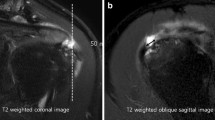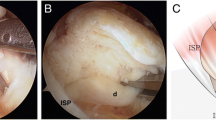Abstract
Background
It remains unclear whether the deep layer of the rotator cuff is an articular layer of the supraspinatus (SS) or infraspinatus (IS), rotator cable, or superior capsule. Therefore, this study aimed to analyse the relationship between occupation ratios and delamination patterns of rotator cuff tears (RCTs). We hypothesised that the deep layers are related to the occupation ratios of the deep SS and IS sections.
Materials and Methods
A total of 265 patients with RCTs were retrospectively enrolled between 2013 and 2017 and divided into four groups: A, non-delaminated tear; B, delaminated tear with the deep layer equally retracted to the superficial layer; C, delaminated tear with the deep layer more retracted; D, delaminated tear with the superficial layer more retracted. Muscle volume was evaluated by measurement of each occupation ratio of the SS and IS, and the IS muscle was additionally divided into two areas, deep and superficial.
Results
The SS occupation ratio was significantly lower in group C than in the other groups (p = 0.009). Conversely, comparison of the IS occupation ratios revealed no significant intergroup differences. The occupation ratio of the superficial IS was significantly lower in group D than in the other groups (p = 0.003). In group C, the occupation ratios of the deep IS section were significantly decreased according to RCT size (p = 0.034).
Conclusion
Our findings demonstrate that the superficial layers are related to the IS superficial section and the deep layers to the SS and IS deep sections.
Level of Study
IV.




Similar content being viewed by others
Change history
12 June 2020
The original version of
References
Boileau, P., Brassart, N., Watkinson, D. J., Carles, M., Hatzidakis, A. M., & Krishnan, S. G. (2005). Arthroscopic repair of full-thickness tears of the supraspinatus: Does the tendon really heal? Journal of Bone and Joint Surgery. American Volume,87, 1229–1240.
Flurin, P. H., Landreau, P., Gregory, T., et al. (2005). Arthroscopic repair of full-thickness cuff tears: A multicentric retrospective study of 576 cases with anatomical assessment. Revue de Chirurgie Orthopedique et Reparatrice de l’Appareil Moteur,91, 31–42.
Sonnabend, D. H., & Watson, E. M. (2002). Structural factors affecting the outcome of rotator cuff repair. Journal of Shoulder and Elbow Surgery,11, 212–218.
Sonnabend, D. H., Yu, Y., Howlett, C. R., Harper, G. D., & Walsh, W. R. (2001). Laminated tears of the human rotator cuff: A histologic and immunochemical study. Journal of Shoulder and Elbow Surgery,10, 109–115.
Kato, A., Nimura, A., Yamaguchi, K., Mochizuki, T., Sugaya, H., & Akita, K. (2012). An anatomical study of the transverse part of the infraspinatus muscle that is closely related with the supraspinatus muscle. Surgical and Radiologic Anatomy,34, 257–265.
Cha, S. W., Lee, C. K., Sugaya, H., Kim, T., & Lee, S. C. (2016). Retraction pattern of delaminated rotator cuff tears: Dual-layer rotator cuff repair. Journal of Orthopaedic Surgery and Research,11, 75.
Mochizuki, T., Sugaya, H., Uomizu, M., et al. (2008). Humeral insertion of the supraspinatus and infraspinatus. New anatomical findings regarding the footprint of the rotator cuff. Journal of Bone and Joint Surgery. American,90, 962–969.
Michelin, P., Trintignac, A., Dacher, J. N., Carvalhana, G., Lefebvre, V., & Duparc, F. (2014). Magnetic resonance anatomy of the superior part of the rotator cuff in normal shoulders, assessment and practical implication. Surgical and Radiologic Anatomy,36, 993–1000.
Yoo, J. S., Heo, K., Park, S. G., Ham, H. J., & Seo, J. B. (2019). The supraspinatus occupation ratios of both the ≥ 50% articular- and bursal-side partial-thickness rotator cuff tears were low and the infraspinatus occupation ratio of the ≥ 50% bursal-side partial-thickness rotator cuff tears was low. Knee Surg Sports Traumatol Arthrosc,27, 3871–3880.
Tanaka, M., Nimura, A., Takahashi, N., et al. (2018). Location and thickness of delaminated rotator cuff tears: Cross-sectional analysis with surgery record review. JSES Open Access,2, 84–90.
Han, Y., Shin, J. H., Seok, C. W., Lee, C. H., & Kim, S. H. (2013). Is posterior delamination in arthroscopic rotator cuff repair hidden to the posterior viewing portal? Arthroscopy,29, 1740–1747.
Bacle, G., Gregoire, J. M., Patat, F., et al. (2017). Anatomy and relations of the infraspinatus and the teres minor muscles: A fresh cadaver dissection study. Surgical and Radiologic Anatomy,39, 119–126.
de Jesus, J. O., Parker, L., Frangos, A. J., & Nazarian, L. N. (2009). Accuracy of MRI, MR arthrography, and ultrasound in the diagnosis of rotator cuff tears: A meta-analysis. American Journal of Roentgenology,192, 1701–1707.
Cicchetti, D. V., & Sparrow, S. A. (1981). Developing criteria for establishing interrater reliability of specific items: Applications to assessment of adaptive behavior. American Journal of Mental Deficiency,86, 127–137.
Sasaki, T., Shitara, H., Yamamoto, A., et al. (2018). What is the appropriate reference for evaluating the recovery of supraspinatus muscle atrophy after arthroscopic rotator cuff repair? The occupation ratio of the supraspinatus may change after rotator cuff repair without volumetric improvement. American Journal of Sports Medicine,46, 1416–1423.
Park, Y. B., Ryu, H. Y., Hong, J. H., Ko, Y. H., & Yoo, J. C. (2016). Reversibility of supraspinatus muscle atrophy in tendon-bone healing after arthroscopic rotator cuff repair. American Journal of Sports Medicine,44, 981–988.
Lhee, S. H., Singh, A. K., & Lee, D. Y. (2017). Does magnetic resonance imaging appearance of supraspinatus muscle atrophy change after repairing rotator cuff tears? Journal of Shoulder and Elbow Surgery,26, 416–423.
Choo, H. J., Lee, S. J., Kim, J. H., et al. (2015). Delaminated tears of the rotator cuff: Prevalence, characteristics, and diagnostic accuracy using indirect MR arthrography. American Journal of Roentgenology,204, 360–366.
Seo, J. B., Yoo, J. S., Jang, H. S., & Kim, J. S. (2015). Correlation of clinical symptoms and function with fatty degeneration of infraspinatus in rotator cuff tear. Knee Surgery, Sports Traumatology, Arthroscopy,23, 1481–1488.
Thomazeau, H., Rolland, Y., Lucas, C., Duval, J. M., & Langlais, F. (1996). Atrophy of the supraspinatus belly. Assessment by MRI in 55 patients with rotator cuff pathology. Acta Orthopaedica Scandinavica,67, 264–268.
Kikukawa, K., Ide, J., Kikuchi, K., Morita, M., Mizuta, H., & Ogata, H. (2014). Hypertrophic changes of the teres minor muscle in rotator cuff tears: Quantitative evaluation by magnetic resonance imaging. Journal of Shoulder and Elbow Surgery,23, 1800–1805.
Chung, S. W., Oh, K. S., Moon, S. G., et al. (2017). Serial changes in 3-dimensional supraspinatus muscle volume after rotator cuff repair. Am Joint Sports Med,45, 2345–2354.
Rahu, M., Kolts, I., Poldoja, E., & Kask, K. (2017). Rotator cuff tendon connections with the rotator cable. Knee Surgery, Sports Traumatology, Arthroscopy,25, 2047–2050.
Park, J. S., Park, H. J., Kim, S. H., & Oh, J. H. (2015). Prognostic factors affecting rotator cuff healing after arthroscopic repair in small to medium-sized tears. American Journal of Sports Medicine,43, 2386–2392.
Zilber, S., Carillon, Y., Lapner, P. C., Walch, G., & Nove-Josserand, L. (2007). Infraspinatus delamination does not affect supraspinatus tear repair. Clinical Orthopaedics and Related Research,458, 63–69.
Vidt, M. E., Santago, A. C., 2nd, Tuohy, C. J., et al. (2016). Assessments of fatty infiltration and muscle atrophy from a single magnetic resonance image slice are not predictive of 3-dimensional measurements. Arthroscopy,32, 128–139.
Oh, J. H., Park, M. S., & Rhee, S. M. (2018). Treatment strategy for irreparable rotator cuff tears. Clinics in Orthopaedic Surgery,10, 119–134.
Jeong, H. Y., Kim, H. J., Jeon, Y. S., & Rhee, Y. G. (2018). Factors predictive of healing in large rotator cuff tears: Is it possible to predict retear preoperatively? American Journal of Sports Medicine,46, 1693–1700.
Author information
Authors and Affiliations
Corresponding author
Ethics declarations
Conflict of interest
The authors declare that they have no conflict of interest.
Ethical standard statement
The study was approved by the local ethics committee and has therefore been performed in accordance with the ethical standards laid down in the 1964 Declaration of Helsinki and its later amendments.
Informed consent
For this type of study informed consent is not required.
Additional information
Publisher's Note
Springer Nature remains neutral with regard to jurisdictional claims in published maps and institutional affiliations.
Rights and permissions
About this article
Cite this article
Seo, J., Yang, J., Heo, K. et al. Relation of Superficial and Deep Layers of Delaminated Rotator Cuff Tear to Supraspinatus and Infraspinatus Insertions. JOIO 54, 366–373 (2020). https://doi.org/10.1007/s43465-019-00020-6
Received:
Accepted:
Published:
Issue Date:
DOI: https://doi.org/10.1007/s43465-019-00020-6




